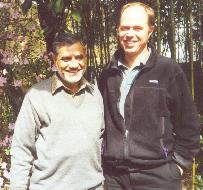|
ALLAHABAD, India, January 19, 2001 (ENS) - Seventy million people are expected to immerse themselves in the waters of the Ganges River during Maha Kumbh Mela, or Great Sacred Jug Festival. Hindus believe the immersion will purify their souls, but this holiest of rivers, though once revered for its purity, is now terribly polluted. The 42 day Hindu ritual began January 14 at Allahabad, some 375 miles southeast of New Delhi, and will end with the bathing on February 21. Pilgrims have arrived from all over the world. The alignment of planets this year will not be repeated for 144 years (by which time the river will be ..?) Myths say that at the beginning of creation, all the gods were under a curse that made them weak and cowardly. Brahma, the creator god, advised them to retrieve the Kumbh (pot) containing the nectar of immortality (amrit). The gods sought help from the demons, and together they churned the ocean to bring up the nectar. As Dhanwantari, the divine healer, appeared with the Kumbh containing nectar in his palms, a great fight ensued between the gods and demons over the pitcher. During the battle, a few drops of nectar fell from the sky in four places: Allahabad, Haridwar, Nasik and Ujjain. Since then, when the planets align in the same position, pilgrims and devotees converge to commemorate this sacred event. Kumbh Mela takes place every three years in rotation in the four sacred places. Kumbh Mela at Allahabad, the most holy of these fairs, only takes place every twelfth year. On January 24, the largest congregation of the new millennium is expected at Allahabad. Over 30,000,000 people will take a holy dip in the river. The power of mythology will far outway the scientific information from the Sankat Mochan Foundation which tests fecal coliform levels in the Ganges. The test results show levels of these microorganisms are far above what would be considered safe for bathing or drinking. Untreated raw sewage enters the river at Varanasi and at many other places in the Ganges River which is home to nearly one-tenth of the world's population. But the urban development minister of Uttar Pradesh state where Allahbad is located is satisfied that the bathing waters along the four mile stretch of the Ganges where the festival is taking place are safe for pilgrims. In the past 50 years, thousands of industries have been built along the Ganges River. Tanneries, chemical plants, textile mills, distilleries and slaughter houses discharge untreated wastewater through a myriad of open drains and canals. Despite a misguided and expensive government program launched in the 1980s, the Ganga Action Plan, only a small fraction of sewage receives treatment before entering the river. The plan for installing domestic wastewater treatment plants in major cities along the river has been a failure, critics charge. India's judiciary, spurred by the efforts of India's pioneering environmental attorney M.C. Mehta, is responding to the challenge of reversing the river's decline. Beginning with a series of landmark judgments that gave Indians a constitutional right to a healthy environment, the Supreme Court of India has ordered hundreds of polluting industries to clean up or close down. Recently, Mehta and advocates from two major cities along the river, Kanpur and Varanasi, convinced the Allahabad High Court in Uttar Pradesh to halt the Ganga Action Plan (GAP) while a special committee advises the court about the best options for wastewater treatment. The GAP has wasted millions of dollars on energy intensive wastewater treatment plants that have failed due to inadequate power supply, sub-standard construction and lack of trained personnel. For instance, millions have been spent setting up a wastewater treatment plant in Varanasi that does not work. Local advocates are proposing the use of simpler wastewater treatment systems that take into account local conditions. The Environmental Law Alliance Worldwide (E-LAW), an international network of over 250 public interest scientists and lawyers, is giving Mehta and other Indian advocates the legal and scientific information they need to challenge polluters and lobby for more appropriate wastewater treatment technologies. Next week, E-LAW U.S. staff scientist Dr. Mark Chernaik, an attorney with a doctorate in biochemistry, will travel to Kumbh Mela at Allalahbad with other U.S. environmentalists and public interest environmental lawyers. They will work with Mehta and his colleagues to strengthen efforts to clean up the Ganges. The meetings will focus on strategies for further judicial action and the practicalities of enforcing court orders involving thousands of factories along hundreds of kilometers of the Ganges River. The scale of the judicial action is without precedent in the field of environmental law. But Dr. Chernaik is not bringing his bathing suit because in his view the Ganges is too polluted for safe immersion. "It would be like taking a bath in raw sewage," Cherniak says. He says bathers risk getting infectious diseases such as dysentery, cholera and hepititis. The visiting environmentalists will meet influential religious leaders and public officials who oversee implementation of Ganga Action Plan to share the message of river clean-up and environmental law enforcement. .
|

